 , 陈瑀2,3, 封梦娟2,4, 王博2, 卜元卿2, 张圣虎2
, 陈瑀2,3, 封梦娟2,4, 王博2, 卜元卿2, 张圣虎2

1. 北京百灵天地环保科技股份有限公司, 北京 100045;
2. 生态环境部南京环境科学研究院, 南京 210042;
3. 贵州大学资源与环境工程学院, 贵阳 550025;
4. 中国药科大学工学院, 南京 211198
收稿日期: 2019-10-20; 修回日期: 2019-11-21; 录用日期: 2019-11-21
基金项目: 国家重点研发计划项目(No.2017YFD0800705)
作者简介: 李辉(1983-), 男, E-mail:48138377@qq.com
通讯作者(责任作者): 张圣虎, E-mail:zsh@nies.org
摘要:采用固相萃取-液相色谱-串联质谱技术(SPE-HPLC-MS/MS),对南京市饮用水源地抗生素含量及分布特征进行了分析.结果表明,17个采样点总浓度为0.56~1994.96 ng·L-1,共检出5种大环内酯类、13种磺胺类、3种四环素类、8种喹诺酮类抗生素,平均浓度为0.30~37.07 ng·L-1,其中检出浓度最高的抗生素为环丙沙星(CIP),浓度为317.60 ng·L-1,检出率最高的抗生素为克林霉素(CLI),检出率为88.24%.与国内部分河流相比,南京市饮用水源地水体中大环内酯类、四环素类、喹诺酮类抗生素残留浓度处于较高水平.生态风险评估结果表明,点位S7具有最高的联合风险熵值(24.58),氧氟沙星(OFX)的风险熵值最高,达到13.06;健康风险评估结果表明,9种抗生素对人体健康的风险熵QH为1.70×10-3~9.47,强力霉素(DOX)、诺氟沙星(NOR)、恩诺沙星(ERX)、CIP和OFX对大部分年龄段的人体健康具有高水平风险.
关键词:抗生素饮用水源地长江南京段生态风险健康风险
Pollution characteristics and risk assessment of antibiotics in Nanjing drinking water sources
LI Hui1
 , CHEN Yu2,3, FENG Mengjuan2,4, WANG Bo2, BU Yuanqing2, ZHANG Shenghu2
, CHEN Yu2,3, FENG Mengjuan2,4, WANG Bo2, BU Yuanqing2, ZHANG Shenghu2

1. Beijing Larkworld Environmental Technology Incorporated Company, Beijing 100045;
2. Nanjing Institute of Environmental Sciences, Ministry of Ecology and Environment, Nanjing 210042;
3. College of Resources and Environmental Engineering, Guizhou University, Guiyang 550025;
4. School of Engineering, Pharmaceutical University, Nanjing 211198
Received 20 October 2019; received in revised from 21 November 2019; accepted 21 November 2019
Abstract: The pollution characteristics of antibiotics in water source of Najing were analyzed by using the solid-phase extraction and high performance liquid chromatography-tandem mass spectrometry (SPE-HPLC-MS/MS).The result showed that the total detected concentration of 17 sampling points ranged from 0.56 to 1994.96 ng·L-1, and five macrolides, thirteen sulfonamides, three tetracycline, eight fluoroquinolones were detected with average concentration ranged from 0.30 ng·L-1 to 37.07 ng·L-1, including ciprofloxacin(CIP) with the highest concentration of 317.60 ng·L-1 and clindamycin(CLI) with the highest detection of 88.24%. Compared with some rivers in China, the macrolides, tetracyclines and fluoroquinolones antibiotics in the Nanjing Drinking water sources are at a relatively high level. The risk assessment results show that the largest cumulative risk of S7 is 24.58, and the highest risk quotient of ofloxacin(OFX) is 13.06; the health risk quotients of nine antibiotics range from 1.70×10-3 to 9.47, and doxycycline (DOX), norfloxacin (NOR), enrofloxacin (ERX), CIP and OFX have a high level of health risk for most age groups.
Keywords: antibioticssource of drinking waterNanjing reach of the Yangtze Riverecological riskhealth risks
1 引言(Introduction)抗生素作为一类可以选择性抑制或杀灭其他生物体活性的微生物次级代谢产物或人工合成的类似物(王娅南等, 2018), 被广泛应用于人类疾病的预防与治疗、畜牧业与水产养殖业等(Le Page et al., 2017).据估计, 世界上每年的抗生素消费量从10万吨到20万吨不等, 并且抗生素消费量仍在逐年上升(Chen et al., 2018).相关数据表明, 我国仅2013年就消耗了约16.2万吨抗生素(Zhang et al., 2015).由于抗生素不能被人或动物完全吸收, 因此大多数抗生素在使用后以其原始形态排放到环境中(杨钊等, 2019).抗生素在环境中可以以一定的速率降解, 但是由于抗生素的不断使用, 导致其在环境中呈现出“假持久性”的状态(孙秋根等, 2018), 进而对生态系统的稳定和人体健康造成潜在的威胁(Na et al., 2019).现有研究表明, 我国多处河流及饮用水源地均检出不同水平的抗生素, 给水生态系统和人体健康带来了潜在风险(张涛等, 2017;Chen et al., 2017).
长江南京段上起江宁区和尚港, 下至栖霞区大道河口, 全长约98 km, 共有18个水功能区, 包括5个饮用水水源区, 4个保留区, 2个缓冲区, 7个渔业、农业、工业用水区(沈乐, 2012).作为南京市重要的饮用水源地, 其水质安全尤为重要, 然而, 对该区域抗生素污染特征的研究还相对较少.本研究采集长江南京段以及3处水库的表层水样, 使用SPE-HPLC-MS/MS方法分析了6类40种抗生素在17个采样点位的污染水平, 并对生态风险及人体健康风险进行了初步评估, 以期为抗生素的环境管理提供基础数据支撑.
2 材料与方法(Materials and methods)2.1 样品采集2017年9月, 在南京长江段14个采样点位(S1~S14)以及3处水库(S15~S17)(图 1)使用有机玻璃采集器采集3 L表层水样, 采集深度为0.1~1 m.将采集到的水样置于用去离子水润洗3次的棕色玻璃瓶中, 低温避光保存, 并于24 h内运回实验室, 用0.45 μm玻璃纤维滤膜过滤后储存在4 ℃冰箱内, 于3 d内完成水样的预处理.
图 1(Fig. 1)
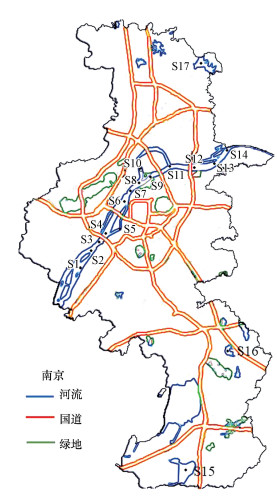 |
| 图 1 南京市饮用水源地采样点示意 Fig. 1Sampling sites from Nanjing Drinking Water Sources |
2.2 仪器与试剂主要仪器设备:质谱分析仪采用AB SCIEX QTRAP 4500三重四极杆线性离子阱复合质谱仪(美国Agilent公司), 联合LC-Agilent 1290二元液相色谱系统(美国Agilent公司);6 mL/500 mg Oasis HLB小柱(美国Waters公司);R-300旋转蒸发仪(瑞士BUCHI公司);24孔固相萃取装置(美国Waters公司).
主要试剂:甲醇、乙腈(色谱纯, 德国Merck公司);甲酸和氨水(分析纯, 国药集团药业股份有限公司);乙二胺四乙酸二钠(EDTA · Na2)、磷酸和二氢钠磷酸(分析纯, 南京化学试剂有限公司).
抗生素标准品均购自百灵威科技有限公司, 纯度均大于99%, 各抗生素理化性质见表 1.分别用甲醇将40种抗生素标准品配制成1000 mg · L-1标准储备液, 然后取标准贮备液配制20 mg · L-1混合标准物质储备液, 存储在-20 ℃冰箱中待用.
表 1(Table 1)
| 表 1 抗生素理化性质 Table 1 The physicochemical properties of antibiotcs | ||||||||||||||||||||||||||||||||||||||||||||||||||||||||||||||||||||||||||||||||||||||||||||||||||||||||||||||||||||||||||||||||||||||||||||||||||||||||||||||||||||
表 1 抗生素理化性质 Table 1 The physicochemical properties of antibiotcs
| ||||||||||||||||||||||||||||||||||||||||||||||||||||||||||||||||||||||||||||||||||||||||||||||||||||||||||||||||||||||||||||||||||||||||||||||||||||||||||||||||||||
2.3 样品预处理参照本课题组建立的方法(封梦娟等, 2019).取1.0 L过滤后的水样, 加入5 mL 100 g · L-1 EDTA · Na2溶液, 再用体积比50%的磷酸水溶液调节水样pH至3.0左右.依次向HLB小柱内加入5 mL甲醇、5 mL超纯水和5 mL磷酸二氢钠水溶液活化小柱, 调节小柱流速为4 mL · min-1, 活化完成后以相同流速富集水样.抽干水样后向采样瓶中加入10 mL超纯水, 抽真空干燥50 min后, 依次用6 mL甲醇和6 mL体积比2%的氨水甲醇洗脱.洗脱液在40 ℃下旋转蒸发近干, 用甲醇复溶至1 mL, 使用HPLC-MS/MS分析.
2.4 仪器分析条件色谱条件:测定采用规格为150 mm×2.1 mm×3.5 μm的ZORBAX Eclipse Plus C18色谱柱, 柱温设定为30 ℃, 样品进样体积为5 μL, 流速为0.3 mL · min-1.氯霉素类抗生素测定流动相为0.2%(体积比)氨水溶液和乙腈, 在5 min时将流动相氨水溶液/乙腈比例从85/15调整到30/70, 在5.5 min时调整到10/90, 在6.5 min时调整到85/15, 洗脱至第10 min结束;大环内酯类、磺胺类、喹诺酮类、四环素类和内酰胺类抗生素测定流动相为0.2% (体积比)甲酸水溶液和乙腈, 在第5 min时将流动相甲酸水溶液/乙腈比例从99/1调整到90/10, 在第25 min时, 调整到50/50, 在第26 min时, 调整到99/1, 洗脱至第30 min结束.
质谱条件:采用离子电喷雾正或负离子(ESI+/ESI-), 多反应监测(MRM)模式;其中氯霉素类抗生素采用ESI-模式, 大环内酯类、磺胺类、喹诺酮类、四环素类和内酰胺类抗生素采用ESI+模式;设定离子源温度为550 ℃, 喷雾电压为5500 V, 喷雾气、气帘气和辅助加热气的压力分别为60.0、35.0和65.0 kPa.
2.5 质量控制选定6个不同浓度梯度的标准物质溶液, 所得标准曲线在0.1~500 μg · L-1拟合度高, 所有抗生素的R2均大于0.950;在100 mL离子水中加入2 μg · L-1的混合标样进行回收率测定, 所得回收率为41.3%~112.6%, 相对标准偏差为0.2%~12.7%.
2.6 风险评估2.6.1 生态风险评估根据欧洲风险评估技术指导文件(European commission technical guidance document, TGD)中不同环境风险评估方法, 可以采用风险熵值法(risk quotient, RQ)对南京市饮用水源地水体中抗生素的生态风险进行评估(Papageorgiou et al., 2019), 风险熵值(RQ)计算公式如下:
 | (1) |
 | (2) |
2.6.2 健康风险评估为评估南京市饮用水源地水体中抗生素对人体健康的风险, 根据人体对抗生素的日均可接受量(ADI), 计算抗生素对人体健康的风险熵值(RQH).计算公式如下:
 | (3) |
饮用水当量值计算公式如下:
 | (4) |
表 2(Table 2)
| 表 2 成人及儿童平均体重以及每日饮水量 Table 2 Average body weight and daily water intake for adults and children | ||||||||||||||||||||
表 2 成人及儿童平均体重以及每日饮水量 Table 2 Average body weight and daily water intake for adults and children
| ||||||||||||||||||||
当RQH小于0.01时, 表明抗生素对人体健康造成的风险水平可忽略不计;当RQH大于0.01小于0.1时, 表明抗生素对人体健康造成的风险属于低水平;当RQH大于0.1小于1时, 表明抗生素对人体健康造成的风险属于中等水平;当RQH大于1时, 表明抗生素对人体健康造成的风险处于高水平.
3 结果与讨论(Results and discussion)3.1 南京市饮用水源地水体中抗生素污染状况及分布特征南京市饮用水源地水体中共检出4类29种抗生素.检出浓度最高的是喹诺酮类抗生素, 其次是四环素类抗生素, 分别占检出抗生素总量的66.26%和21.43%;检出浓度最低的是磺胺类抗生素, 浓度为ND~18.8 ng · L-1, 检出率为5.07%~33.49%;检出浓度最高的抗生素为CIP, 浓度为317.6 ng · L-1;检出率最高的抗生素为CLI, 达到了88.24%(图 2).
图 2(Fig. 2)
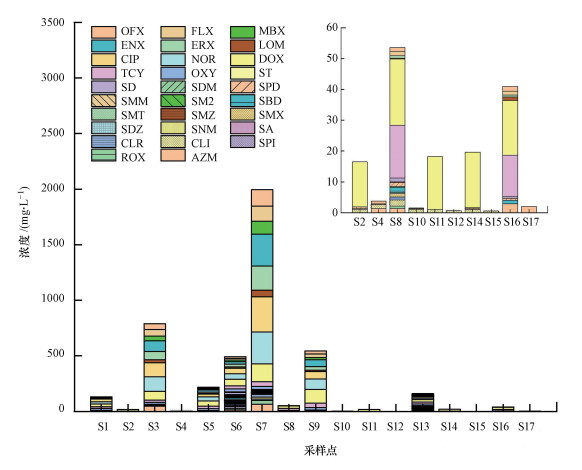 |
| 图 2 南京市饮用水源地4类抗生素在各采样点质量浓度分布 Fig. 2The mass concentration distribution of 4 kinds of antibiotics in Nanjing Drinking Water Sources |
如图 2所示, 抗生素在S1~S17检出浓度为0.56~1994.96 ng · L-1, 中值为40.98 ng · L-1, 平均值为264.12 ng · L-1, 其中S7(燕子矶工业区)点位抗生素检出浓度最高(1994.96 ng · L-1), 可能是由于附近医院、生活区等造成了点源污染, S15(太湖区水库)点位检出浓度最低(0.56 ng · L-1).
17个采样点中共检出8种喹诺酮类抗生素, 其中S3、S5、S6、S7、S9、S13 6个点检出了6种喹诺酮类抗生素.在17个检测点检出的喹诺酮类抗生素中, OFX检出率最高, 达到55.82%, 浓度范围为ND~147.6 ng · L-1;CIP检出浓度最高, 达到317.6 ng · L-1, 检出率为41.18%.在已检出的四类抗生素中, 喹诺酮类抗生素含量最高, 这与吕凯等(2019)对河流中抗生素含量的研究结果一致.目前由于喹诺酮类抗生素较好的疗效和较低的价格, 因而成为人类疾病和动物疾病治疗的一类常用抗生素, 而且在众多广谱抗生素中, 喹诺酮类抗生素半衰期最长, 此外, 城镇污水处理厂现有工艺对喹诺酮类抗生素的去除效果并不明显(Mulla et al., 2018), 导致水体中喹诺酮类抗生素含量普遍偏高.
17个采样点共检出13种磺胺类抗生素, 其中S6点磺胺类抗生素含量最高, 达到135.35 ng · L-1, 可能是由于S6点附近为渔业用水区.在17个检测点检出的磺胺类抗生素中, SPD检出率最高, 达到76.47%, 浓度为ND~9.54 ng · L-1;SD检出浓度最高, 达到18.8 ng · L-1, 检出率达到41.18%.跟其它3类检出的抗生素相比, 磺胺类抗生素在17个点中浓度含量最低, 平均值为12.13 ng · L-1.
17个采样点中共检出3种四环素类抗生素, 其中DOX检出率与检出浓度都是最高, 为70.59%和160 ng · L-1, 浓度为ND~160 ng · L-1, 中位值为18.04 ng · L-1.四环素类抗生素广泛应用于禽畜和水产养殖业, 但在水体中浓度含量相对较低, 可能是由于四环素类抗生素相对较短的半衰期, 以及在迁移过程中容易被底泥吸附有关(陈琼等, 2019).
17个采样点中共检出5种大环内酯类抗生素, 其中CLI检出率最高, 达到88.24%, 浓度为ND~16.36 ng · L-1;AZM检出浓度最高, 达到65.2 ng · L-1, 检出率为64.71%.大环内酯类抗生素在南京市饮用水源地水体中整体含量较低, 略高于磺胺类抗生素, 可能由于其高疏水和易吸附于沉积物的特性(Murata et al., 2011), 导致在水体中检出浓度偏低.
利用百分含量分布图以及主成分分析对南京市饮用水源地检出的29种抗生素进行分析.如图 3所示, 选取两个主要成分合占总方差的95.10%, 其中成分1占67.81%, 成分2占27.29%.由图可知, 本文所研究的抗生素类污染物可被分为3个集群:① SA、SNM、SDZ、SMX、SMZ、SMT、SBD、SM2、SMM、SPD、SDM、SD和ST, 均为磺胺类污染物, 集中分布在采样点S6、S7和S13, 其他采样点未检出或检出量较低;②SPI, 该污染物在仅在采样点S6和S7有检出;③其他抗生素污染物, 在17个采样点中均有不同程度的检出, 分布较为广泛.由此可知, 同类抗生素的污染分布具有一定的相似性.
图 3(Fig. 3)
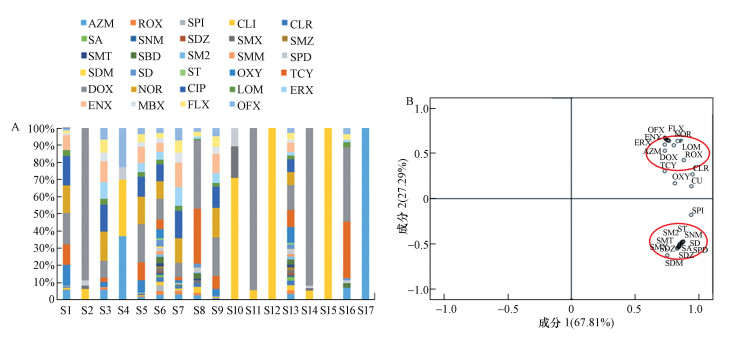 |
| 图 3 南京市饮用水源地29种抗生素在采样点的百分含量分布图(a)及主成分分析图(b) Fig. 3Percentage distribution(a) and principal component analysis(b) of 29 antibiotics in Nanjing Drinking Water Sources |
3.2 南京市饮用水源地水体中抗生素污染与国内河流对比结果由于近5年来国外相关报道较少, 因此仅对国内河流进行抗生素含量对比, 对南京市饮用水源地水体检出率较高(>50%)的抗生素与国内河流进行比较分析, 见表 3(Chen et al., 2018;Hu et al., 2018;Lin et al., 2018;He et al., 2018).
表 3(Table 3)
| 表 3 国内部分河流抗生素的污染水平对比 Table 3 Comparison of antibiotic pollution levels in some rivers in China | ||||||||||||||||||||||||||||||||||||||||||||||||||||||||||||||||||||||||||||||||||||||||||||||||||||||||||||||||||||||||||||||||||||||||||||||||||||||||||||||||||||||||||||||||||||||||||||||||||||||||||||||||||||||||||||||||||||||||||||||||||||||||||||||||||||||||||||||||||||||||||||||
表 3 国内部分河流抗生素的污染水平对比 Table 3 Comparison of antibiotic pollution levels in some rivers in China
| ||||||||||||||||||||||||||||||||||||||||||||||||||||||||||||||||||||||||||||||||||||||||||||||||||||||||||||||||||||||||||||||||||||||||||||||||||||||||||||||||||||||||||||||||||||||||||||||||||||||||||||||||||||||||||||||||||||||||||||||||||||||||||||||||||||||||||||||||||||||||||||||
SMX检出率为64.71%, 平均浓度达到0.98 ng · L-1, 与湘江均处于较低的浓度水平;TCY检出率为52.94%, 平均浓度达到12.72 ng · L-1, 远高于汉江中TCY的检出浓度, 低于东江源头区域TCY的检出浓度;DOX检出率为70.59%, 平均浓度达到35.68 ng · L-1, 远高于国内其他河流的检出浓度;OFX在南京市饮用水源地水体中检出率为58.82%, 平均浓度为15.26 ng · L-1, 远高于其他地区检出浓度.由此可见, 南京市饮用水源地水体中大环内酯类、四环素类和喹诺酮类抗生素残留量处于高浓度水平.
3.3 南京市饮用水源地水体中抗生素的生态风险评估及人体健康评估3.3.1 生态风险评估由于单一抗生素的生态风险不能充分反映抗生素对环境的潜在危害, 因此采用联合风险熵值法进行评估.由于不同种类抗生素对不同物种的毒性不同, 因此选用最敏感物种的PNEC作为评估值, 如表 4所示(Lutzhoft et al., 1999;Eguchi et al., 2004;Robinson et al., 2005;Isidori et al., 2005;Turkdogan et al., 2009;Yang et al., 2010;Kim et al., 2010;Bia?k-Bielińska et al., 2011;Hossain et al., 2018;彭聪等, 2019).
表 4(Table 4)
| 表 4 不同抗生素对应最敏感生物毒理数据 Table 4 Most sensitive biotoxicological data for different antibiotics | |||||||||||||||||||||||||||||||||||||||||||||||||||||||||||||||||||||||||||||||||||||||||||||||||||||||||||||||||||||||||||||||||||||||||||||||||||
表 4 不同抗生素对应最敏感生物毒理数据 Table 4 Most sensitive biotoxicological data for different antibiotics
| |||||||||||||||||||||||||||||||||||||||||||||||||||||||||||||||||||||||||||||||||||||||||||||||||||||||||||||||||||||||||||||||||||||||||||||||||||
由图 3可以看出, S2、S4、S10等8个点的RQsum均小于0.1, 表明水体中抗生素所造成的生态风险处于低或可忽略的水平, 进入水体的抗生素对环境基本没有影响;S1、S8、S13和S16的RQsum在0.1和1之间, 表明水体中的抗生素所造成的生态风险处于中等水平;S3、S5、S6、S7和S9的RQsum大于1, 表明水体中抗生素所造成的生态风险处于高水平, 如果这5个点抗生素含量长期处于该水平, 环境中的微生物可能会逐渐产生耐药性, 对生态环境的稳定及人体健康造成潜在危害.
抗生素种类不同, 对环境的生态风险也不同.由图 4可知, CLI、CLR、SNM、SDZ、SMX、SMT、SM2、SMM、SDM、ST和LOM共计11种抗生素的生态风险可忽略;OFX的生态风险最高, RQ的范围在0~13.06之间, 生态风险处于高水平状态.
图 4(Fig. 4)
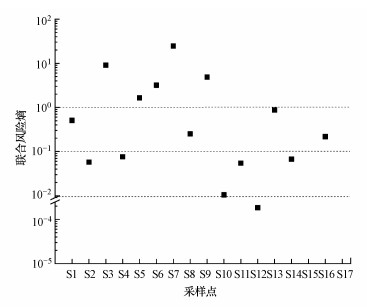 |
| 图 4 南京市饮用水源地各采样点抗生素的联合生态风险熵 Fig. 4RQsum of detected antibiotics at samples from Nanjing Drinking Water Sources |
3.3.2 人体健康评估由于南京饮用水源地水体中大环内酯类、四环素类和喹诺酮类抗生素浓度比其他地区明显偏高, 因此对这3类抗生素进行人体健康评估, 通过查阅相关文献得出相关ADI值, 如表 5所示(Schwab et al., 2005;Hanna et al., 2018;Wang et al., 2018;闭凤丽等, 2018).
表 5(Table 5)
| 表 5 不同抗生素的ADI值 Table 5 ADI with different antibiotics | ||||||||||||||||||||||||||||||
表 5 不同抗生素的ADI值 Table 5 ADI with different antibiotics
| ||||||||||||||||||||||||||||||
选取最大抗生素检出浓度, 计算南京饮用水源地水体中抗生素对人体健康的风险值.由图 5可知, DOX、CIP、ERX和OFX 4种抗生素的RQH大于1, 对成人和儿童的身体健康造成高水平风险, 应减少其排放量;NOR的RQH在0.1和1之间, 对成人和儿童的身体健康造成中等风险, 应控制其排放量;ROX、CLI、OXY和TCY的RQH小于0.1, 对成人和儿童的身体健康造成低风险.
图 5(Fig. 5)
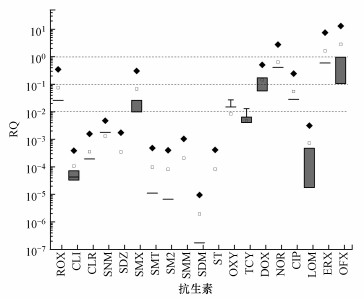 |
| 图 5 南京饮用水源地不同种类抗生素的生态风险 Fig. 5Ecological risks of different types of antibiotics in the Nanjing Drinking Water Sources |
图 6(Fig. 6)
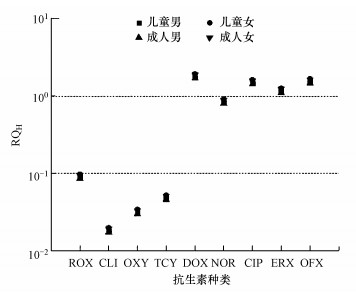 |
| 图 6 不同种类抗生素对人体健康的风险评估 Fig. 6Risk assessment of different types of antibiotics to human health |
4 结论(Conclusions)1) 南京市饮用水源地水体共检出4类29种抗生素, 浓度为0.08~317.6 ng · L-1, 检出浓度最高的抗生素为CIP, 最高浓度达到317.6 ng · L-1, 检出浓度最低的抗生素为SBD, 浓度为0.08 ng · L-1;四类抗生素检出水平依次为:喹诺酮类(ND~1566.8 ng · L-1)>四环素类(ND~231.4 ng · L-1)>大环内酯类(0.56~154.56 ng · L-1)>磺胺类(ND~112.27 ng · L-1).
2) 对比国内河流, 南京市饮用水源地水体大环内酯类、四环素类和喹诺酮类抗生素均处于较高污染水平, 磺胺类抗生素处于低污染水平.
3) 采样点S3、S5、S6、S7和S9处于高风险水平, 对环境造成的生态风险最高, 其中OFX的生态风险最高, RQ的范围在0~13.06之间, 处于高水平;DOX、CIP、ERX和OFX 4种抗生素对成人和儿童的身体健康造成高水平风险.
参考文献
| Bia?k-Bielińska A, Stolte S, Arning J, et al. 2011. Ecotoxicity evaluation of selected sulfonamides[J]. Chemosphere, 85(6): 928-933. |
| Chen Y, Chen H, Zhang L, et al. 2018. Occurrence, distribution, and risk assessment of antibiotics in a subtropical river-reservoir system[J]. Water, 10(2): 104. |
| Chen Z, Yu D, He S, et al. 2017. Prevalence of antibiotic-resistant escherichia coli in drinking water sources in Hangzhou City[J]. Frontiers in Microbiology, 8: 1133. |
| Cleuvers M. 2003. Aquatic ecotoxicity of pharmaceuticals including the assessment of combination effects[J]. Toxicology Letters, 142(3): 185-194. |
| Chen Y, Chen H, Zhang L, et al. 2018. Occurrence, distribution, and risk assessment of antibiotics in a subtropical river-reservoir system[J]. Water, 10(2): 104. |
| Eguchi K, Nagase H, Ozawam M, et al. 2004. Evaluation of antimicrobial agents for veterinary use in the eco-toxicity test using microalgae[J]. Chemosphere, 57(11): 1733-1738. |
| Hanna N, Sun P, Sun Q, et al. 2018. Presence of antibiotic residues in various environmental compartments of Shandong province in eastern China:Its potential for resistance development and ecological and human risk[J]. Environment International, 114: 131-142. |
| Hu Y, Yan X, Shen Y, et al. 2018. Antibiotics in surface water and sediments from Hanjiang River, Central China:Occurrence, behavior and risk assessment[J]. Ecotoxicology and Environmental Safety, 157: 150-158. |
| He S, Dong D, Zhang X, et al. 2018. Occurrence and ecological risk assessment of 22 emerging contaminants in the Jilin Songhua River (Northeast China)[J]. Environmental Science and Pollution Research, 25(24): 24003-24012. |
| Hossain A, Nakamichi S, Habibullah-Al-Mamun M, et al. 2018. Occurrence and ecological risk of pharmaceuticals in river surface water of Bangladesh[J]. Environmental Research, 165: 258-266. |
| Hanna N, Sun P, Sun Q, et al. 2018. Presence of antibiotic residues in various environmental compartments of Shandong province in eastern China:Its potential for resistance development and ecological and human risk[J]. Environment International, 114: 131-142. |
| Isidori M, Lavorgna M, Nzrdelli A, et al. 2005. Toxic and genotoxic evaluation of six antibiotics on non-target organisms[J]. Science of the Total Environment, 346(1/3): 87-98. |
| Kim J, Park J, Kim P G, et al. 2010. Implication of global environmental changes on chemical toxicity-effect of water temperature, pH, and ultraviolet B irradiation on acute toxicity of several pharmaceuticals in Daphnia magna[J]. Ecotoxicology, 19(4): 662-669. |
| Le Page G, Gunnarsson L, Snape J, et al. 2017. Integrating human and environmental health in antibiotic risk assessment:A critical analysis of protection goals, species sensitivity and antimicrobial resistance[J]. Environment International, 109: 155-169. |
| Lin H, Chen L, Li H, et al. 2018. Pharmaceutically active compounds in the Xiangjiang River, China:Distribution pattern, source apportionment, and risk assessment[J]. Science of the Total Environment, 636: 975-984. |
| Lutzhoft H C H, Halling S B, Jorgensen S E. 1999. Algal toxicity of antibacterial agents applied in Danish fish farming[J]. Archives of Environmental Contamination and Toxicology, 36: 1-6. |
| Mulla S I, Hu A Y, Sun Q, et al. 2018. Biodegradation of sulfamethoxazole in bacteria from three different origins[J]. Journal of Environmental Management, 206: 93-102. |
| Murata A, Takada H, Mutoh K, et al. 2011. Nationwide monitoring of selected antibiotics:distribution and sources of sulfonamides, trimethoprim, and macrolides in Japanese rivers[J]. Science of the Total Environment, 409(24): 5305-5312. |
| Na T W, Kang T, Lee K, et al. 2019. Distribution and ecological risk of pharmaceuticals in surface water of the Yeongsan river, Republic of Korea[J]. Ecotoxicology and Environmental Safety, 181: 180-186. |
| Papageorgiou M, Zioris I, Danis T, et al. 2019. Comprehensive investigation of a wide range of pharmaceuticals and personal care products in urban and hospital wastewaters in Greece[J]. Science of the Total Environment, 694: 133565. |
| Qiao M, Ying G, Singer A C, et al. 2018. Review of antibiotic resistance in China and its environment[J]. Environment International, 110: 160-172. |
| Robinson A A, Belden J B, Lydy M J. 2005. Toxicity of fluoroquinolone antibiotics to aquatic organisms[J]. Environmental Toxicology and Chemistry, 24(2): 423. |
| Schwab B W, Hayes E P, Fiori J M, et al. 2005. Human pharmaceuticals in US surface waters:A human health risk assessment[J]. Regulatory Toxicology and Pharmacology, 42(3): 296-312. |
| Shi W, Zhang F, Zhang X, et al. 2011. Identification of trace organic pollutants in freshwater sources in Eastern China and estimation of their associated human health risks[J]. Ecotoxicology, 20(5): 1099-1106. |
| Turkdogan F I, Yetilmezsoy K. 2009. Appraisal of potential environmental risks associated with human antibiotic consumption in Turkey[J]. Journal of Hazardous Materials, 166(1): 297-308. |
| Wang J, Wei H, Zhou X, et al. 2019. Occurrence and risk assessment of antibiotics in the Xi'an section of the Weihe River, northwestern China[J]. Marine Pollution Bulletin, 146: 794-800. |
| Wang H X, Yang J Q, Yu X, et al. 2018. Exposure of adults to antibiotics in a Shanghai suburban area and health risk assessment:A biomonitoring-based study[J]. Environmental Science & Technology, 52(23): 13942-13950. |
| Yang L H, Ying G G, Su H C, et al. 2010. Growth-inhibiting effects of 12 antibacterial agents and their mixtures on the freshwater microalga Pseudokirchneriella subcapitata[J]. Environmental Toxicology & Chemistry, 27(5): 1201-1208. |
| Zhang R, Zhang R, Zou S, et al. 2017. Occurrence, distribution and ecological risks of fluoroquinolone antibiotics in the Dongjiang River and the Beijiang River, Pearl River Delta, South China[J]. Bulletin of Environmental Contamination and Toxicology, 99(1): 46-53. |
| Zhang Q, Ying G, Pan C, et al. 2015. Comprehensive evaluation of antibiotics emission and fate in the river basins of China:Source analysis, multimedia modeling, and linkage to bacterial resistance[J]. Environmental Science & Technology, 49(11): 6772-6782. |
| 闭凤丽, 李志广, 刘波, 等. 2018. 南方某地区水体抗生素含量及风险评估[J]. 环境化学, 37(3): 621-624. |
| 陈琼, 丁惠君, 张维昊, 等. 2019. 滨湖底泥对2种喹诺酮类抗生素的吸附作用研究[J]. 环境科学与技术, 42(6): 106-114. |
| 封梦娟, 杨正标, 张芹, 等. 2019. 高效液相色谱-串联质谱法同时测定表层水体中5类40种抗生素[J]. 色谱, 37(5): 525-532. |
| 环境保护部. 2014. 中国人群暴露参数手册(成人卷)[M]. 北京: 中国环境科学出版社. |
| 吕凯, 刘晓薇, 邓呈逊, 等.SPE-RRLC-MS/MS测定河水和沉积物中14种典型抗生素[J/OL].环境化学: 1-10[2019-11-13]. http://kns.cnki.net/kcms/detail/11.1844.X.20191105.1436.002.html. |
| 彭聪, 巴俊杰, 胡芬, 等. 2019. 广西会仙岩溶湿地典型抗生素污染特征及生态风险评估[J]. 环境科学学报, 39(7): 2207-2217. |
| 孙秋根, 王智源, 董建玮, 等. 2018. 太湖流域河网4种典型抗生素的时空分布和风险评价[J]. 环境科学学报, 38(11): 4400-4410. |
| 沈乐. 2012. 长江南京段六大饮用水水源地水质变化及原因[J]. 水资源保护, 28(1): 71-75. |
| 王娅南, 彭洁, 黄合田, 等. 2018. 贵阳市城市河流典型抗生素的分布特征[J]. 环境化学, 37(9): 2039-2048. |
| 杨钊, 李江, 张圣虎, 等. 2019. 贵阳市污水处理厂中典型抗生素的污染水平及生态风险[J]. 环境科学, 40(7): 3249-3256. |
| 张涛, 郭晓, 刘俊杰, 等. 2017. 江西梅江流域土壤中四环素类抗生素的含量及空间分布特征[J]. 环境科学学报, 37(4): 1493-1501. |
